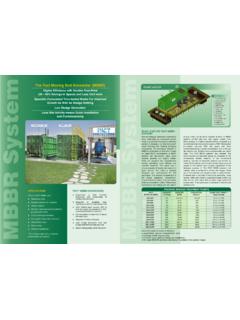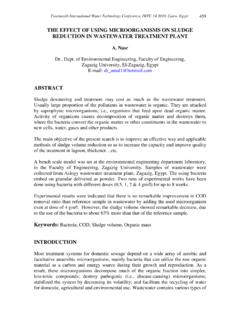Transcription of Glossary of Wastewater Terms - mgsdistrict.org
1 Glossary of Wastewater Terms Activated sludge sludge that has undergone flocculation forming a bacterial culture typically carried out in tanks. Can be extended with aeration. Advanced Primary Treatment The use of special additives to raw Wastewater to cause flocculation or clumping to help settling before the primary treatment such as screening. Advanced Wastewater Treatment Any advanced process used above and beyond the defacto typical minimum primary and secondary Wastewater treatment. Aerobic Wastewater Treatment Oxygen dependent Wastewater treatment requiring the presence of oxygen for aerobic bacterial breakdown of waste.
2 Alkalinity A measure of a substances ability to neutralize acid. Water containing carbonates, bicarbonates, hydroxides, and occasionally borates, silicates, and phosphates can be alkaline. Alkaline substances have a pH value over 7 Anaerobic Wastewater Treatment Wastewater treatment in the absence of oxygen, anaerobic bacteria breakdown waste. Bacteria Single cell microscopic living organisms lacking chlorophyll, which digest many organic and inorganic substances. An essential part of the ecosystem including within human beings. Bioengineering The use of living plants as part of the system, be it Wastewater treatment, erosion control, water polishing, habitat repair and on.
3 Biosolids Rich organic material leftover from aerobic Wastewater treatment, essentially dewatered sludge that can be re-used. BOD - Biochemical Oxygen Demand Since oxygen is required in the breakdown or decomposition process of Wastewater , its "demand" or BOD, is a measure of the concentration of organics in the Wastewater . Clarifier A piece of Wastewater treatment equipment used to "clarify" the Wastewater , usually some sort of holding tank that allows settling. Used when solids have a specific gravity greater than 1. COD - Chemical Oxygen Demand The amount of chemical oxidant required to breakdown the wastes, also an indicator of the concentration of organics.
4 Cold Climate Limitations The limitations of various Wastewater treatment options caused by severe cold and its incidents such as ice, snow, very low temperatures and so on. Combined Sewer Combining the municipal sewer systems with storm drainage. Risks overpowering the system in large rain events. The benefit is that pollutants from storm drainage get treated, Combined Sewer Overflow (CSO) When a combined sewer system is overpowered by storm drainage and overflows. Constructed Wetland An artificially created wetland usually with a waterproof lining for Wastewater purification. Detention, flow rates, types of plants and other parameters are controlled to improve BOD, SS and N removal.
5 Typical riparian plants like cattails and reeds are used to provide bacteria with an oxygenating root zone. Detention Time - Retention Time, Residence Time How long on average Wastewater undergoes the Wastewater treatment process. Time vary greatly across various types of Wastewater treatment, from minutes to weeks. Dewatered sludge The sludge after it's been dewatered, also know as sludge cake. Dewatered sludge Cake The sludge after dewatering that is cake like, compressed. The lower the water content the better for Wastewater treatment purposes. Dewatering Removing water from sludge or other solids. Digestion The breaking down of sludge and other waste biologically by microorganisms.
6 Results in byproducts such as methane gas, carbon dioxide, sludge solids and water. Aerobic digestion requires oxygen, anaerobic digestion the absence of oxygen. Denitrification Biologically removing nitrate converting it to nitrogen gas. Disinfection The use of chemicals to kill any disease causing organisms in the polished Wastewater . UV light can also be used. Dissolved Oxygen (DO) The amount of oxygen dissolved in the water. Measured in milligrams per liter. Ecological Engineering Systems designs that are considered to be "sustainable", that is with the aim of having little to no impact on earth's ecology.
7 See Industrial Ecology. Effluent The final output flow of a Wastewater treatment plant. Extended Aeration An aeration system that adds aerobic sludge digestion to the activated sludge process. Facultative Ponds Wastewater ponds with some form of aeration for oxygen replenishment. Can also use algae and other plants for oxygen replenishment. Floc Particulate and or bacterial clumps forming wooly looking clusters in Wastewater . In biological processes such as extended aeration or activated sludge and others the floc contains aerobic or anaerobic microorganisms. For industrial applications flocculants are used.
8 Flocculation The process whereby a chemical or other substance is added to Wastewater to trap or attract the particulate suspended solids into clusters or clumps of floc or flocculent, wooly looking masses. Flocculating Agent The flocculant or chemical used to cause flocculation. Flocculant Same as flocculating agent, the catalyst substance that causes the chemical reaction with TSS to form flocculent many times encapsulating the solids. Flocculent The "floc" or wooly mass of clusters that is formed in flocculation. Many times used interchangeably with "flocculant" however truly refers to the floc mass and not the catalyst flocculating agent.
9 Free Water Surface Wetland (FWS) A constructed wetland or other shallow Wastewater treatment pond where the shallow water is exposed directly to the air. Grease Fats, soaps, oils, waxes and etc. in Wastewater . Grit Chamber Usually in municipal Wastewater treatment, a chamber or tank in which primary influent is slowed down so heavy typically inorganic solids can drop out, such as metals and plastics. Headworks The beginning of the treatment plant where the influent begins treatment. Industrial Ecology Industrial Ecology (IE) focuses on combining perpetually desirable outcomes in environment, economy and technology sustainably.
10 The primary tenet is that all systems mimic nature and are thus closed loop, continuous, circular. In Wastewater treatment industrial ecology would mean that all so called "waste" is re-input into the same or other process. For example, biosolids as fertilizer can be considered a use of sludge consistent with industrial ecology. Recycling Wastewater into the treatment plant, manufacturing or other process is another example. Industrial Wastewater Treatment Wastewater treatment for industries such as manufacturing, food processing, corrugators, printing and so on. Paper and pulp mills' treatment of Wastewater is an example of industrial Wastewater treatment.








